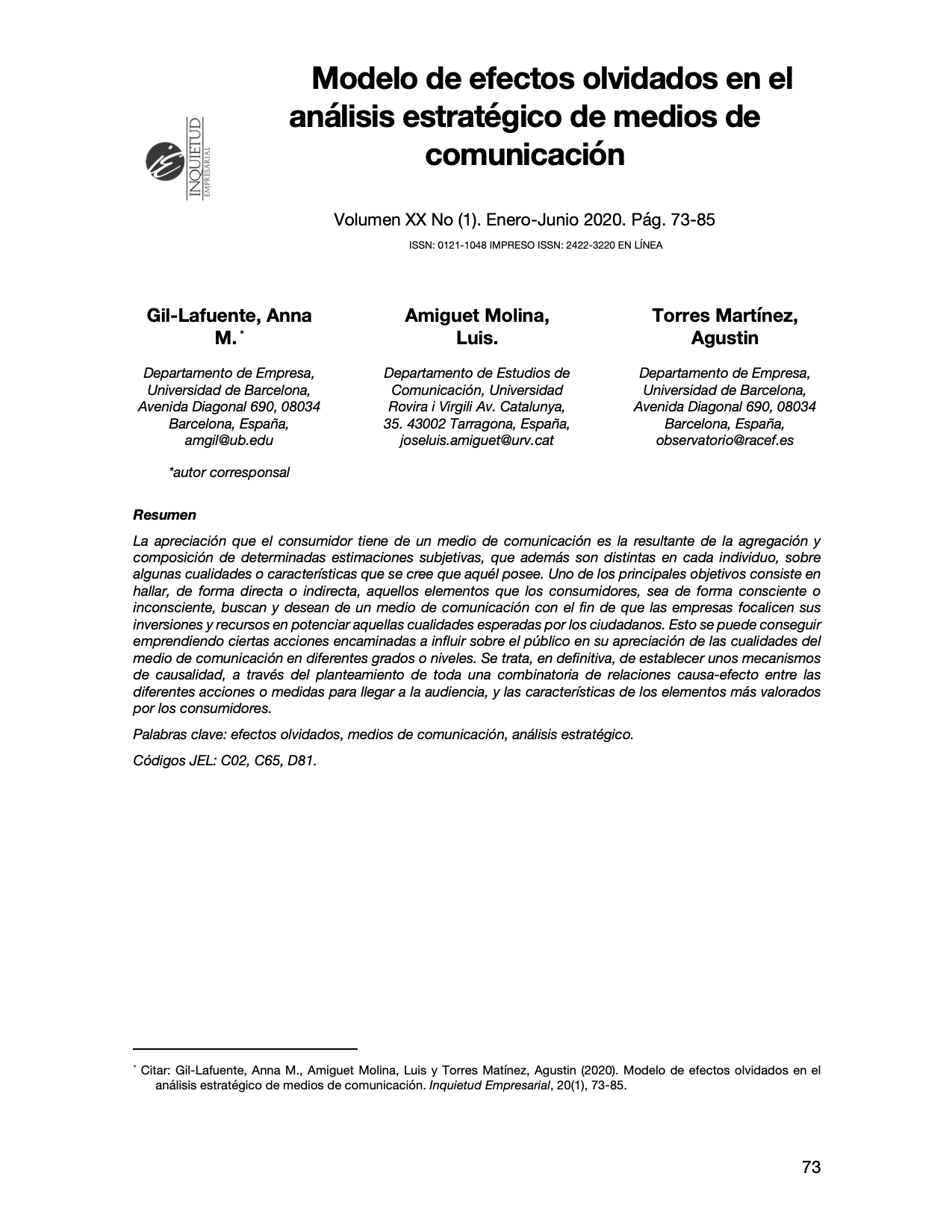Forgotten effects model in the strategic analysis of media

Abstract
The consumer's appreciation of a means of communication is the result of the aggregation and composition of certain subjective estimates, which are also different in each individual, about some qualities or characteristics that a particular medium is believed to have. One of the main objectives is to find, directly or indirectly, those elements that consumers, whether consciously or unconsciously, seek and want about a means of communication. The purpose is for companies to focus their investments and resources on enhancing those qualities expected by citizens. This can be achieved by implementing actions aimed at influencing the audience in their appreciation of the qualities of the media at different levels. Therefore, we intend to establish mechanisms of causality, through different combinations of cause-effect relationships between the actions or measures to reach the audience, and the characteristics of the media most valued by consumers.
Key words: forgotten effects, media, strategic analysis.
JEL Classification: C02, C65, D81.
Received: 04/04/2019. Accepted: 25/06/2020. Published: 30/06/2020.
Keywords
forgotten effects, media, strategic analysis
References
- Baez-Palencia, D., Olazabal-Lugo, M. & Romero-Muñoz, J. (2019). Toma de decisiones empresariales a través de la media ponderada ordenada. Inquietud Empresarial, 19(2), 11-23. DOI: https://doi.org/10.19053/01211048.9843
- Callejo, J. (2001). Investigar las audiencias. Un análisis cualitativo. Barcelona: Ediciones Paidós Ibérica S.A.
- Castello-Martinez, A. (2011). ¿Cuánto vale un fan? El reto de la medición de la audiencia en los social media. Pensar la Publicidad. Revista Internacional de Investigaciones Publicitarias, 4(2), 89-110.
- Gil-Lafuente, A. M. (2015). Application of the forgotten effects model to the economic effects for public European health systems by the early diagnostics of emergent and rare diseases. Procedia Economics and Finances, 22(2014), 10–19. DOI: https://doi.org/10.1016/S2212-5671(15)00221-X
- Gil-Lafuente, A. M., & Barcellos de Paula, L. (2010). Una aplicación de la metodología de los efectos olvidados: los factores que contribuyen al crecimiento sostenible de la empresa. Cuadernos del CIMBAGE, 12(12), 23–52.
- Guerrero Serón, C. A. (1993). Determinación de audiencias: una aplicación multivariable. Questiones Publicitarias, 1, 16–41. DOI: https://doi.org/10.5565/rev/qp.147
- Kaufmann, A., & Gil Aluja, J. (1988). Modelos para la investigación de efectos olvidados. (Milladoiro, Ed.). Santiago de Compostela.
- Gil-Lafuente, A. M., & Luis-Bassa, C. (2011). Identificación de los atributos contemplados por los clientes en una estrategia CRM utilizando el modelo de efectos olvidados the forgotten effects model in a crm strategy. Cuadernos del CIMBAGE, 13(13), 107–127.
- Jauset, J.A. (2000). La investigación de audiencias en televisión. Fundamentos estadísticos. Barcelona: Ediciones Paidós Ibérica S.A.
- Maqueda Lafuente, F. J., Gil Lafuente, A. M., Guzman-Parra, V., & Gil Lafuente, J. (2013). Key factors for entrepreneurial success. Management Decision, 51(10), 1932–1944. DOI: https://doi.org/10.1108/MD-04-2013-0201
- Martorell-Cunill, O., Gil-Lafuente, A. M., Socias Salvà, A., & Mulet Forteza, C. (2014). The growth strategies in the hospitality industry from the perspective of the forgotten effects. Computational and Mathematical Organization Theory, 20(2), 195–210. DOI: https://doi.org/10.1007/s10588-013-9167-9
- Parra Boyero, E. (1991). Predicción de audiencia de televisión mediante redes neuronales. Universidad de Málaga.
- Quintas-Froufe, N., & González-Neira, A. (2014). Audiencias activas: participación de la audiencia social en la televisión. Comunicar: Revista científica iberoamericana de comunicación y educación, (43), 83-90. DOI: https://doi.org/10.3916/C43-2014-08
- Rodriguez Rubinos, J. M., Ramirez Reyes, M. A., & Díaz Pontones, V. (2008). Efectos olvidados en las relaciones de causalidad de las acciones del sistema de capacitación en las organizaciones empresariales. Revista de Métodos Cuantitativos para la Economía y la Empresa, 5.
- Sánchez Carrión, J. J. (1988). Análisis de tablas de contingencia. (Centro de Investigaciones Solciológicas CIS, Ed.).
- Vizuete Luciano, E., Gil‐Lafuente, A. M., García González, A., & Boria‐Reverter, S. (2013). Forgotten effects of corporate social and environmental responsibility. Kybernetes, 42(5), 736–753. DOI: https://doi.org/10.1108/K-04-2013-0065
